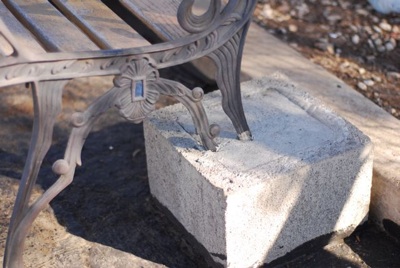Personal Mods
The Apartment at the Mall
A few artists discovered an apartment-sized vacant space under a mall in Providence, RI, and over several years proceeded to build a living space which they furnished (with things bought at the mall) as an “art piece.” The project was called Trummerkind, which is what the Germans called the children and orphans who lived in alleys and abandonded buildings after WWII.
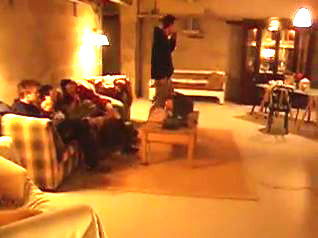
Chief architect of the apartment within the mall was Michael Townsend. He writes on Trummerkind that he got the idea while watching the construction of the mall and noticed the vacant space within it.
Starting in 2003 I committed to the idea of creating a luxury apartment in the mall. Life from within the mall was committed to the pursuit of normalcy and the purchase of objects and clothing that would help define me an active participant in the great things the mall has to offer. During the Christmas season of 2003 and 2004, radio ads for the Providence Place Mall featured an enthusiastic female voice talking about how great it would be if you (we) could live at the mall. The central theme of the ads was that the mall not only provided a rich shopping experience, but also had all the things that one would need to survive and lead a healthy life. This, along with a wide variety of theoretical musings about my relationship to the mall – as a citizen and public artists – provided the final catalyst for making the apartment.
The Providence Journal has a good story on some of the details of living inside a mall in a mall furnished flat. The space was quite spacious and the effort to furnish it, while remaining undetected in the middle of a mall, were herculean.
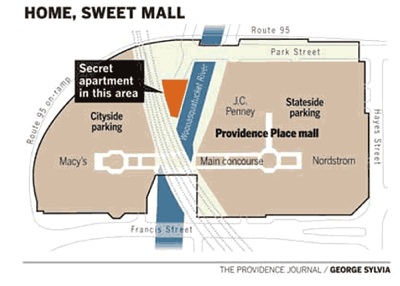
In a feat of derring-do likely to be savored for years by the Providence-area underground-art community, the artists illegally ate, drank, slept, read, held meetings, watched TV and enjoyed games on a Sony Playstation2 in a palace of American commercialism. The apartment, which was relatively soundproof, contained a sectional sofa, a love seat, a coffee table, a breakfast table with four chairs, lamps, a throw rug, a hutch and paintings on the walls. Although the group had bold improvement plans, the apartment lacked running water, a refrigerator and a toilet. The artists lugged in gallon jugs of water to drink, and to answer nature’s call, they would sneak out to use mall bathrooms. They did have a waffle iron, Yoto said, so meals tended to run toward breakfast food. They obtained electricity by running an extension cord to an outlet in the storage room.
The casually furnished, unheated apartment was in a 750-square-foot loft beneath an I-beam and above an unused dusty storage room in the mall parking garage that was accessed through a door in a stairwell, according to Townsend, his fellow artists and the police. The collective labored mightily to haul in more than two tons of construction materials and furnishings to build out and equip the space, which already had a concrete floor. Some of the material was brought in through an 11-inch-wide aperture on the west side of the mall that allowed access to the garage interior. Larger items were brought into the garage by car and carried up fire exit stairwells, the artists said. In order to section off and disguise the space, the artists cemented together 90 30-pound cinderblocks to make a wall and then installed a generic, beige-colored industrial door. Anyone who came into the storage room would see a steep metal ladder leading to the locked door.
Two other points to note from this article. One is that the inhabitants were once burglarized. The thief made off with their Playstation. Townsend said that this room became a home once it was burglarized. The other thing is Townsend’s incredibly gracious note to the police and security guards, apologizing for “wasting their time” and for being professional while dealing with this very “peculiar” case. Five points for style!
Power Cart
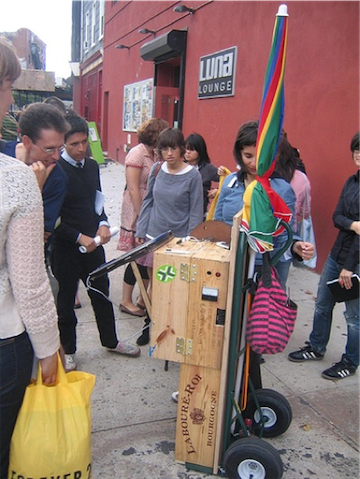
This prototype of a prototypical street cart is artist Mouna Andraos’ idea. From the artist’s proposal: “An old idea from yesterday’s streets adapted to serve the needs of today’s urban dwellers, the Power Cart is a mobile unit that delivers alternative power to people in the streets. Street vendors have traditionally played an important role in defining the urban environment and often speak to the current social and cultural context of a city. In most parts of the world (and if the weather permits it), the street is a place where social interactions abound and where commerce rules, and street vendors around the globe bring to local populations the things they need right at their door steps. Knife sharpening in India, refills of gas in Africa, fake Gucci bags in Paris and chair massages in New York, the Power Cart looks and feels like another service for the city of today. Need a charge on your cell phone? Your laptop is about to die and you really need to check that email? Or maybe there is no power around you at all? Where ever you might be in the world, hail the Power Cart for a quick fix. Let the Power Cart owner turn the crank for you and get the electricity you need, one minute of cranking at a time.”
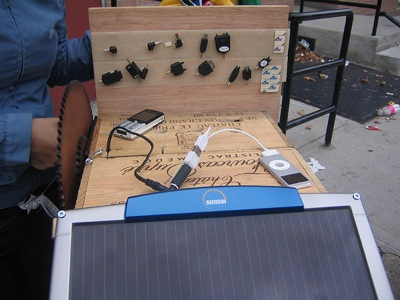
You Can’t Have Too Many Screens
Adam Sender runs the Exis Capital Management Inc., a hedge fund in New York City. He also owns a $100 million modern art collection which he would like to house in an old church in the Hamptons. He has a lot of money and a need for a lot of information. This photo of him in his New York office in January 2007 was shot by Bloomberg News. As you can see, his desk is part performance art, part futuristic demo of what some believe work will be like in the future.

These flat screens were never meant to be piled up and around like this, but when these displays are free (as they essential are to this rich guy), they become a fantastic street use example of where display technology is headed. In this photo I counted 25 screens. Most of Sender’s screens don’t need to be interactive since they appear chiefly as displays of stock movements, which means they are good candidates for electronic wallpaper. If these screens were stitched together into a single desktop as many dual screen sets are (like my own desktop) it might be hard to keep track of where your control cursor was (at least until someone figured out a good way to highlight it across all that real estate).
These screens remind me of a project I once worked on. About 8 years ago, I was part of a small group invited by Steven Spielberg to brainstorm about a future film he was launching. There were some writer types (like myself), some technologists, a few futurists, and one or two science fiction authors, all members of the Global Business Network. Speilberg flew us to Venice Beach, California and holed us up in the Shutters on the Beach Hotel for a day and a half. I remember the spectacular beach was fogged in, so we spent the days in a dim conference room, as a constant stream of assistants whizzed in and out the whole time. We were working from a short story by Philip K. Dick, a sketch really (no script), which was set in the near future. Our assignment was to describe the details of what life would look like in Washington DC in the year 2050. Forecast the future of cars, bedrooms, office space in as realistic and accurate way possible. The movie, of course, was Minority Report.
At the time I had been trying to imagine the office of the future. I suggested to the film team that we would be surrounded by a single seamless screen in an arc, and that we would stand up and gesture into it. I had observed that when you think on your feet you have different thoughts. I like to think while I walk or pace because I feel my whole body is thinking then. It may turn out to be a short-term anomaly that today we think while we are sitting. Perhaps if the right technology were around we’d always think with our entire body in motion. I know I would rather move while mining for new ideas. With that in mind I offered the wall-sized screen arc that you stand before and act. You would interact with the information at a slight distance using your arms. Spielberg’s team found a great designer to make the idea real, and in a brilliant stroke of genius, they turned it into ballet by adding music.
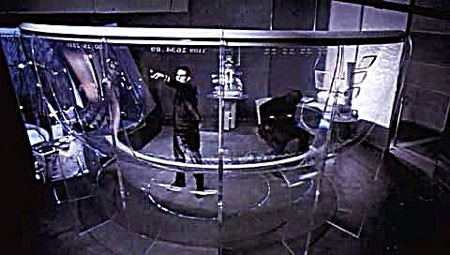
I was simply describing the office I want. So far, Adam Sender is closest to this vision made real, although it is a long way from my ideal. I would be interested in hearing about other experiments in day-to-day surround-display. Can anyone point me to street-ready multiple displays hacked in home offices? How useful are they really? Can you keep track of what is happening behind you? Why not go up, rather than behind?
Sock Exchange
Todd Lapin found this cool “sock exchange” in a San Francisco laundromat (the Bernal Bubbles Laundromat, Cortland Avenue, Bernal
). 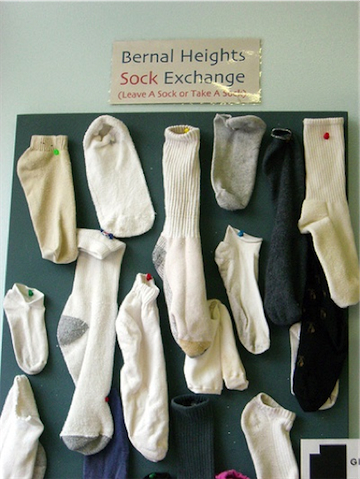
Soviet Self-Made Lawnmower
One of my favorite street-use sites is English-Russia. They frequently feature novel ways that Russians create their own technology. The latest example is this clever home-made lawn mower. The site doesn’t say much about how it was built, but it seems to created around an electric motor and bicycle parts. About all they say about the machine is: “This particular lawnmower still works and sometimes is used by this Russian man on his “dacha”, the summer wooden cottage where he spends some of his weekends, like many other Russians do.”

Public Cartoon Blackboard
According to a BBC news item datelined Nairobi, a one Humphrey Barasa has “has been drawing cartoons on the [Kenyan] bus stop shelter for the last six years.”
The cartoons, which Mr Barasa draws on the face of the shelter, highlight various issues – from politics and politicians, to health and social issues – and act as a pictorial analysis of current affairs….. He has won many fans, who visit the shelter every day to view his latest masterpiece. “It’s very, very excellent work. It always gives me inspiration and that’s why I pass here every day,” said one of his fans.
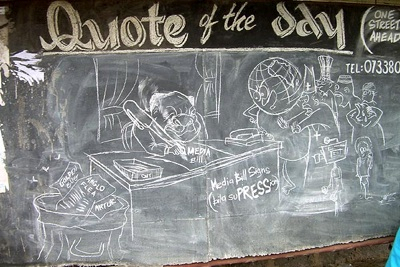
Baby Carriage Mobile Vendor
Reader David Sarpal writes: “My sister is visiting Colombia right now and she happened upon a street vendor who has arrived at an ingenious re-use of a baby carriage as a street vendor.”
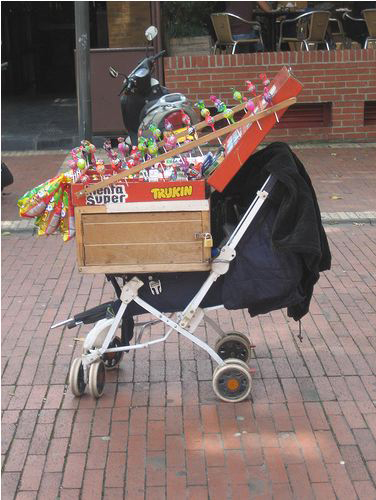
Toilet Ring
Design student Andrew McClandlish sent me this image which was part of a large collection of anonymously photographed street use images from China which has been circulating on the internet for years. But I had not seen this contraption before. It is obviously a clever solution to someone who simply does not want to use a squatty potty.
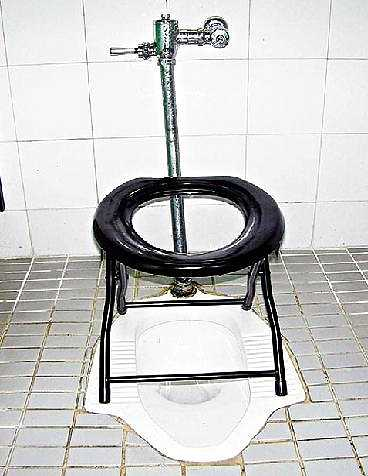
Big Loud Bike Bell For Tricycle
Pedicabs drivers need a big bell — all the momentum they are riding on is hard to stop quickly. These guys in Suzhou had a cool set of bells using an old gear to hold more than one bell. The circle of bells were struck by an armature in the center, turned by the rotation of the front wheel. It made a great big ring! Very cool.

Park Bench Theft Deterrent
A reader named John says he “saw this bench at the car wash in San Diego, CA a few weeks ago and thought of street use. Apparently they dont want their bench stolen.”
It is actually a pretty cool design. It makes the bench heavy and awkward to move. Yet it doesn’t detract from either its use or its looks (too much). And it is probably cheap to make. Also it can easily be applied to a variety of bench types. Why don’t we see this solution more often?
